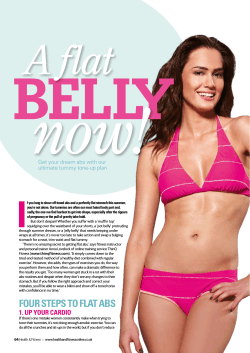
What is Abdominal Muscles after Childbirth (also known as Divarication of
What is Separation of the Abdominal Muscles after Childbirth (also known as Divarication of Rectus Abdominis)? __________________________________________________________________ Following your pregnancy and the birth of your baby your abdominal (tummy) muscles may have become separated in the middle. The separation indicates that these muscles have become over stretched and weakened. The deep abdominal muscles act like a corset around you, supporting and protecting your back. If they are weak you are at greater risk of developing back pain and poor posture. Before Pregnancy ABHB/PIU1111/1 – September 2012 Expiry Date:- September 2015 Post-natal Divarication of Rectus Abdominis Page 1 This leaflet is provided by physiotherapists to give you advice about what you can do to help the problem, and to help prevent you putting extra strain on your back while the muscles are weak. It includes an initial exercise to tone the muscles. If you have not already been seen and assessed by a physiotherapist and are concerned about the separation you have, please ask your Midwife or GP to consider referring you to the out-patient physiotherapy service, especially if you have a separation of more than 2 fingers’ width. How does the separation occur? • The size and position of your growing baby in your pregnancy will have put extra strain on the connective tissue in the midline that separates the two abdominal muscles. • Hormonal changes that occur in pregnancy affect this connective tissue and the muscles and makes them more vulnerable to stretch. • The combination of these two factors may be why your muscles have overstretched and separated. It is a very common problem. Why should I address this problem? It is important to gain control over the gap and reduce any excessive bulging of your abdomen, as you can get abdominal, pelvic and/or low back pain and also put yourself at risk of developing an abdominal hernia. What can I do to help? 1) Do the deep abdominal exercise outlined in this leaflet regularly. 2) To help protect your back ensure that your lower abdomen is drawn in and your pelvic floor is active when doing daily activities. ABHB/PIU1111/1 – September 2012 Expiry Date:- September 2015 Page 2 Getting up from lying down/rolling over in bed Always bend your knees and roll onto your side, keeping your tummy pulled in Laughing, coughing or when opening bowels Hold tummy with hands to stop bulging Pushing the buggy/trolley or using stairs Always practice good posture and draw tummy in Avoid lifting with a twist If you have to lift, draw your tummy muscles in first and use your legs not your back. Changing baby Keep baby at waist height. Bending forward will create more strain on your back IMPORTANT—if you cannot control the bulging of your tummy then limit the aggravating activity as much as possible How can I monitor my progress? You may have noticed at first that your tummy bulged when you coughed, laughed or sat forward. If you are able to hold it flatter and your waist is drawing in, you are improving. To measure the separation: • Lie flat on your back, knees bent and place one hand vertically 2cm above your belly button. • Slowly raise your head and shoulders so that your shoulder blades are off the bed. • Check how many fingers you are able to fit horizontally into this gap and record it. If you are able to control the gap or bulge during the above movement, i.e. it does not get any larger, then you are improving. ABHB/PIU1111/1 – September 2012 Expiry Date:- September 2015 Page 3 Optimum Standing Posture Check your weight is evenly distributed over both feet and they are comfortably parallel, hip width apart. • Unlock your knees. • Check your pelvis and lumbar spine are in mid position, not too flat or over-arched. • Gently draw in your lower tummy muscles and lengthen your spine. • Keep the chest open by keeping your shoulder blades drawn down. • Allow the neck to lengthen. • Eventually you should be able to maintain this posture during daily activities. Exercising • Exercising the deepest abdominal muscle will assist in closing the abdominal muscle separation from the inside. The gap should close to normal i.e. 1-2 finger widths and without any bulging of the muscles. Deep Abdominal Exercise • Lie on your back with your knees bent at a comfortable angle, back and ribs relaxed and feet flat on the floor. • Feel for the bony prominence at the front of the pelvis above the hip on both sides and move your fingers towards the middle 1 inch and down towards your feet 1 inch. ABHB/PIU1111/1 – September 2012 Expiry Date:- September 2015 Page 4 • As you breathe out, draw in your tummy button towards your spine. You should be able to feel the muscle under your fingers stiffen. Make sure your spine has not moved. • Keep your tummy drawn in for 3-5 seconds whilst you breathe normally, and then relax. Work towards holding for 10 seconds, repeated 10 times. IMPORTANT Do not allow your back to arch and try to keep it in midline when exercising or during daily activities. Continue with your pelvic floor exercises regularly. If you are seeing a physiotherapist they will help you to progress your exercises but if the gap is less than 2 fingers, without any bulging, then you are able to progress through the other exercises in the Fit for the Future leaflet provided by your midwife. ABHB/PIU1111/1 – September 2012 Expiry Date:- September 2015 Page 5
© Copyright 2025



















